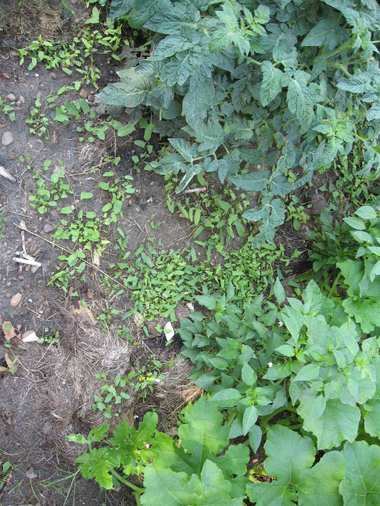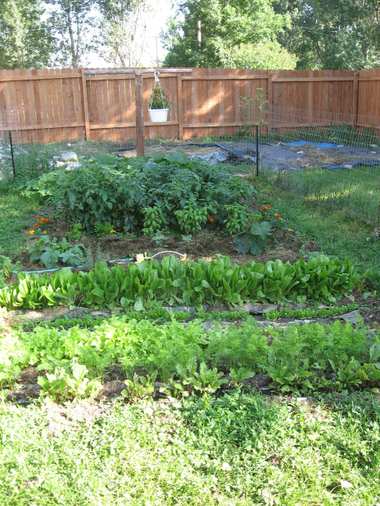This is the first of several posts on bindweed, scourge of the gardener’s life. I’m hoping to hear from plenty of people about methods and tactics. After all, it all started when a woman in the north-east corner of Montana sent me these pictures of her garden:
Those are bind-weed sprouts there against the bare ground and bindweed climbing the tomatoes. (I think those are tomatoes.) Now take a look at this one:
According to Laura, and I have no reason to question her word, ALL that green stuff in the foreground is bindweed. Ouch.
Clearly, this can’t be tackled in a single post. So stay tuned.
Laura asked if I know of anything that works against bindweed. If I did, I’d be a lot richer than I am now. But I do feel like I’m bringing the bindweed in the next-door plot gradually under control. My own policy is to try to reduce the level to something I can stand to deal with. This requires a combination of preparatory digging, weed-cloth, and then hand weeding. Plus a lot of promises about how I’ll do better next year. But as a small-scale example, I thinned the strawberry patche in the spring to the point where I could see and find and pull the bindweed. It’s a matter of picking your battles—making it manageable somehow.
Bindweed is a nearly impossible plant because its rhizomous root structure can extend twenty feet underground. Furthermore, the smallest bit left in the ground will simply generate a new plant. The urge to grab a hoe and hack away at the stuff must be ruthlessly suppressed, since doing so will just break the crisp, friable roots into tiny, fertile bits, producing dozens of new plants.
The only way to dig the stuff up, then, is—very carefully, following root shafts, sifting dirt, and resigning yourself to partial success—the price of mortality, our human condition.
So Laura, here’s what I’d do: Shuffle off this mortal coil and –no, that’s not right. Wrong cue card. Here we go:
I’d get a heavy layer of mulch and weed cloth down over all the paths in the garden, including along the outsides. Then, I’d tackle perhaps one row a year in a way that’s designed to really put a dent in the bindweed there. As for that storm of bindweed in the foreground of the photo, I’d aim at control, not elimination, at least for now.
That’s the general strategy. Now for tactics.
Paths:
I suggested weedcloth. Some might put down black plastic mulch, but this blocks moisture as well as light, and will essentially kill the soil as well as the bindweed over time. Especially in a row garden, your plants need the soil that’s under the paths, so weed cloth would be a much better choice. The newsprint or mulch under the weedcloth is there to ensure that NO light gets to the bindweed roots underneath. Deprived of light, the plants can’t produce foliage, and since it’s foliage that feeds the roots, eventually even those monstrous root systems will be depleted and die.
On that cheerful note, I’ll depart–for the moment. More is on the way.



 Subscribe to RSS feed
Subscribe to RSS feed



I’ve eradicated a severe infestation of Bindweed in my lawn. Here’s my method: http://www.tinyurl.com/5rgbt6. I hope it works for you.
Thanks for the tip! Would you suggest, then, that Laura paint the cut end of each bindweed stem with Roundup? What I wonder is whether an organic herbicide would work as well, given that multiple applications are necessary in either case. Perhaps a small-scale study is in order . . .
–Kate